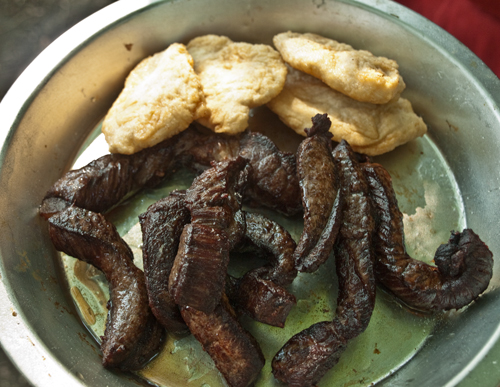On their way to the Little Missouri River in present North Dakota, the landscape is encrusted in white salts and the hills layered with black coal. They make a comfortable dinner of fresh venison, beaver tails, and yesterday’s soggy biscuits. In the Weather Diary, they note the area’s birds, trees, and plants.
Bear Tracks and Venison
by Yellowstone Public Radio[1]Originally aired weekdays by Yellowstone Public Radio during the Bicentennial observance of 2003-2006. Narrated by Hal Hansen. Scripts by Whit Hansen and Ed Jacobson. Produced by Leni Holliman. © … Continue reading
Venison and Biscuits
© 2010 by Kristopher K. Townsend. Permission to use granted under the Creative Commons Attribution-Share Alike 4.0 International license.
A Comfortable Dinner
halted at two P. M. and made a comfortable dinner on a venison stake and beavers tales with the bisquit which got wet on the 8th inst. by the accidant of the canoe filling with water before mentioned.
—Meriwether Lewis
White Earth
on the sides of the hills and even the banks of the rivers and sandbars, there is a white substance t[h]at appears in considerable quantities on the surface of the earth, which tastes like a mixture of common salt and glauber salts.
—Meriwether Lewis
Salty Springs
many of the springs which flow from the base of the river hills are so strongly impregnated with this substance that the water is extreemly unpelasant to the taste and has a purgative effect.—
—Meriwether Lewis
Poor Coal
In maney of those hills forming bluffs to the river we procieve Several Stratums of bituminious Substance which resembles Coal [lignite]; thoug Some of the pieces appear to be excellent Coal it resists the fire for Some[time], and consumes without emiting much flaim.
—William Clark
Weather Diary
State of Thermometer at rise
Weather Wind at rise
State of Thermometer at 4 P.M. Weather Wind at 4 P.M. State of the River 42 [above 0] fair N W 76 [above 0] fair W. fallen ½ in. The lark wood pecker, with yellow wings, and a black spot on the brest common to the U’ States has appeared, with sundry small birds.— many plants begin to appear above the ground.— saw a large white gull today— the Eagle is now laying their eggs, and the gees have mated.— the Elm, large leafed, willow and the bush which bears a red berry, called by the engages [engagés] greas de buff are in blume—
—William Clark and Meriwether Lewis[2]To assist the reader, the editor of this web page has omitted the date column, clarified the “State of the River” information, and spelled out some abbreviations.
Notes
| ↑1 | Originally aired weekdays by Yellowstone Public Radio during the Bicentennial observance of 2003-2006. Narrated by Hal Hansen. Scripts by Whit Hansen and Ed Jacobson. Produced by Leni Holliman. © 2003 by Yellowstone Public Radio. |
|---|---|
| ↑2 | To assist the reader, the editor of this web page has omitted the date column, clarified the “State of the River” information, and spelled out some abbreviations. |

